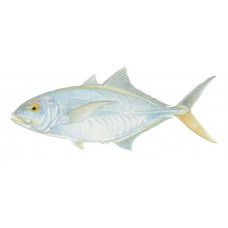Latin name
Caranx bartholomaei
Other names
French: carangue grasse; Spanish: cojinua amarilla, cibi amarillo.
Identification
Silver with a yellow cast, the yellow jack has a bluish back and strongly yellowed flanks, which become even more yellow when the fish dies. The fins are also yellowish, as is the tail. It does not have the black spot near the gill cover that a similar horse-eye jack has, and the head is less steep. The dorsal fin has 25 to 28 soft rays and 18 to 21 gill slits at the lower end of the first arch. Young fish are more copper-colored and have many pale spots.
Distribution
In the western Atlantic, yellow jack is found from Massachusetts to the Gulf of Mexico, including Bermuda, and south from the Caribbean and West Indies to Maceió in Brazil.
Habitat
Common on coastal reefs, usually solitary or moving in small groups at depths of up to 130 feet. Juveniles typically wander ashore in mangrove-bottomed lagoons, often together with jellyfish and floating sargassum.
Size
Averaging less than 2 pounds and 1 to 2 feet in length, it can reach 3 feet and 17 pounds. The world record weighs 19 pounds, 7 ounces.
Life history and Behavior
No information
Food and feeding habits
No information
Reproduction
No information
| Classification | |
| Phylum | Chordata |
| Class | Actinopterygii |
| Squad | Carangiformes |
| Family | Carangidae |
| Genus | Caranx |
| Species | C. bartholomaei |
| Features | |
| Conservation status | Least Concern |
| Habitat | Pelagic |
| Life span, years | No information |
| Maximum body weight, kg | 14 |
| Maximum length, cm | 100 |
| Sailing speed, m/s | No information |
| Threat to people | Edible |
| Way of eating | Predator |



